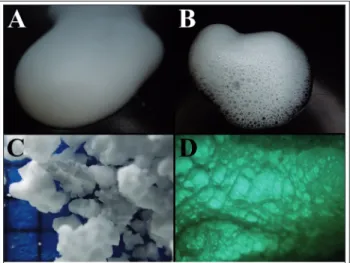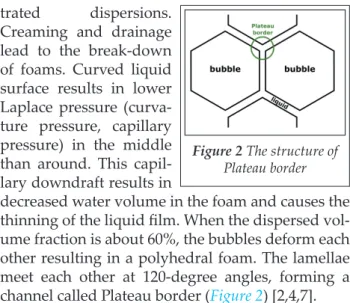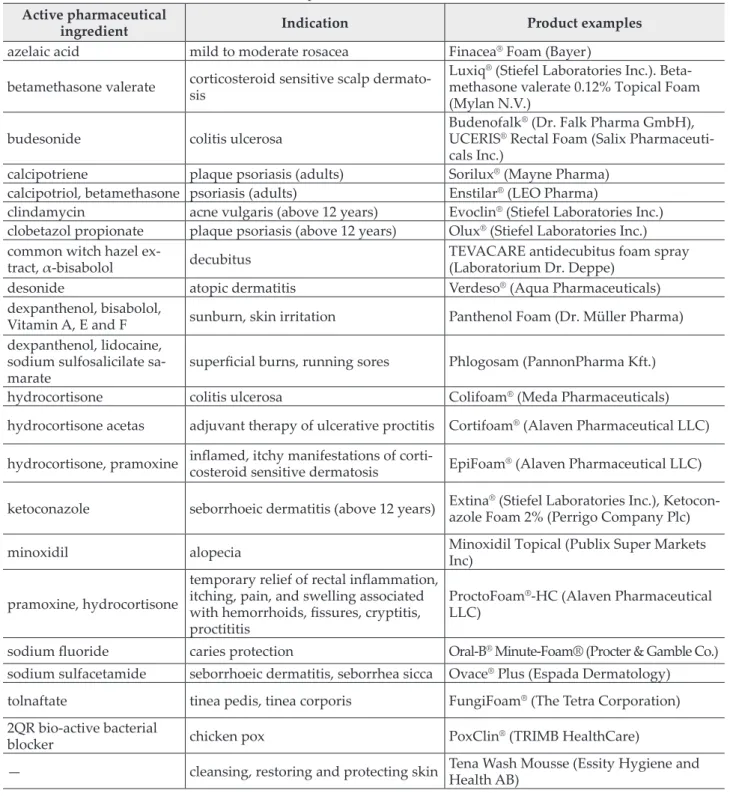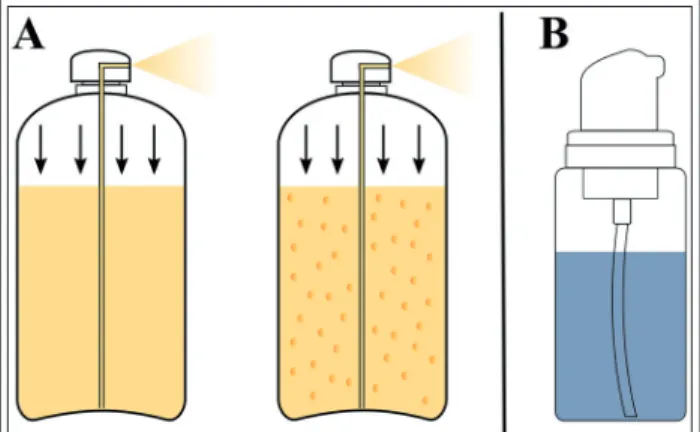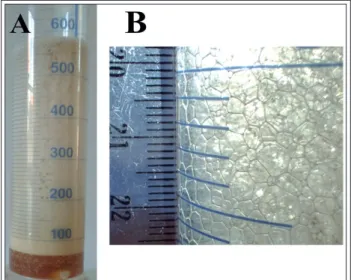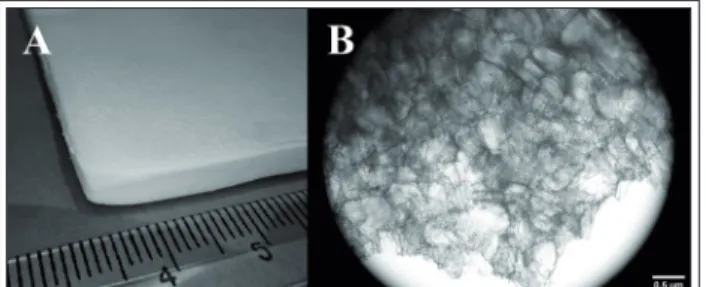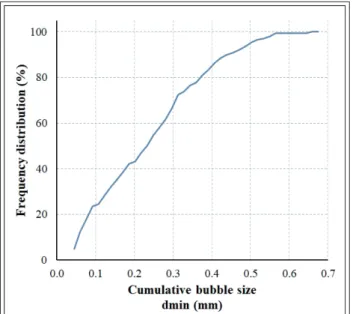Foams as carrier systems for pharmaceuticals and cosmetics
DÓRA FARKAS, NIKOLETT KÁLLAI-SZABÓ, ISTVÁN ANTAL*
Department of Pharmaceutics, Semmelweis University, Hőgyes Str. 7., Budapest, H-1092
*Corresponding author: István Antal E-mail: antal.istvan@pharma.semmelweis-univ.hu
Introduction
According to the conventional classification of col- loid systems, foams (Figure 1) are defined as dis- continuous gas bubbles dispersed in a continuous phase (liquid or solid). Solid foams include thin polymer walls, while traditional liquid foams con- tain thin liquid films separating gas bubble ag- glomerations [1]. Foams can also be described as deformed (laminar difform) lyosols because the dispersing phase is a colloid. The thickness of the lamellae separating the bubbles is in the micro- nanometer range [2].
There are non-aqueous foams too, which with-
out the increase in the liquid phase viscosity, gell- ing, or solidification caused by cooling or polym- erization are only stable for a short time. Due to their low density, good heat-insulating ability, and great mechanical solidity despite the small weight, these solid foams (xerosols, xerogels) are of great industrial significance in several areas, including pharmaceutical industry [2]. Gelatine or collagen- based solid foams, or sponges, containing antibi- otic or steroid active ingredients are often used as primary wound dressings [3]. The mutual attri- bute of all foams that distinguishes them from sponges, irrespectively of the state of the film, is the enclosed bubbles and the lack of connection with the surrounding bubbles, so the gas phase is discontinuous while the liquid or solid phase is continuous [1].
Foam formation
Foams can be produced by two basic methods. The more common, mechanical one is by dispersing the gas phase in the liquid with beating or shaking [2]. The other way is by the gas-supersaturation of the liquid. The gas can be dissolved under pres- sure that is later released or can be formed in situ [4]. In both cases, the lifetime of the foams made of pure liquids is quite short [2]. For an enduring dis- persion, the presence of surface active agents ab- sorbing spontaneously onto the interface is essen- tial. These amphipathic molecules have polar groups that contact with the water and also a hy- Received: 21 January 2019 / Accepted: 8 February 2019 / Published online: 4 April 2019
Abstract
Foams are becoming more and more popular in several areas of our lives, including pharmaceutics and cosmetics. They are colloid sys- tems where gas is dispersed in a liquid phase. Active ingredient bearing pharmaceutical foams are traditionally applied topically (der- mal, local rectal, vaginal), but formulations for other delivery routes (e.g. nanosystems parenterally, solid foams orally) are also avail- able. Numerous advantages are attached to foams when compared to traditional vehicles, resulting in increased patient compliance.
Amongst others, the suitable composition contributes to quick, oily residue free and convenient application even on large or hairy ar- eas, as well as to good drug transfer rate.
Keywords: foam classification and characterization, formulation, excipients, image analysis
Figure 1 Aerosol foam (A); propellant-free foam (B); solid polypropylene foam particles (C); stucture of a gum based
solid foam (D)
drophobic part that orients towards the gas and so creating a monomolecular layer. Surfactants re- duce the energy required for foam formulation by decreasing the surface tension. They also foster the creation of an elastic boundary layer thus increas- ing the lamella stability by inhibiting their taper- ing. This progress can be hindered in different ways: by the presence of hydration shell of the sur- factant molecules or by the repulsion of the ionic surfactant’s electric charges. Another way is by the bulking of partially solvating particles, that reduce the system’s free energy with the amount of adhe- sion work (Wa), at the interface [2,5].
𝑊𝑊! = 𝛾𝛾 ∙ 𝑎𝑎!∙ 𝜋𝜋 ∙ 1 ± cos 𝜃𝜃 !
(1)
where γ is the surface tension, a is the radius of the particle and θ is the contact angle [2].
Aerosol foams are formed due to the overpressure (usually 2-4 bars) when upon actuation the pro- pellant evaporates quickly from the liquid. De- layed foam formulation can be reached by using a propellant with a high boiling point [6].
Foam stability
Due to the excess interfacial Helmholtz free ener- gy, the foams are thermodynamically unstable but can have kinetic stability in case of hampered phase disunion [5].
Ensuring good stability is essential for effective foam forming. Without decent firmness, the struc- ture is to break down partially resulting in in- creased bubble sizes. There are several events oc- curring simultaneously in foams that influence their stability.
Liquid evaporation itself can destroy the foam structure. The type of the surfactant used can in- fluence the speed by altering the nature of the monolayer and result in reduced evaporation [7].
It is known, that the smaller volume phase has higher vapor pressure and better solubility. As a re- sult of the difference in the vapor pressure of vari- ous sized bubbles, the smaller ones disappear grad- ually. This is called Ostwald ripening or dispropor- tionation and it can also be affected by the nature of the monolayer or the type of gas used. The more water-soluble gas results in less stable foams, since it is transported quicker across the films [7,8].
Owing to buoyancy force, in a few minutes after foam forming a creamy layer is observable on top of the liquid phase. Creaming is slower in concen-
trated dispersions.
Cream ing and drainage lead to the break-down of foams. Curved liquid surface results in lower Laplace pressure (curva- ture pressure, capillary pressure) in the middle than around. This capil- lary downdraft results in
decreased water volume in the foam and causes the thinning of the liquid film. When the dispersed vol- ume fraction is about 60%, the bubbles deform each other resulting in a polyhedral foam. The lamellae meet each other at 120-degree angles, forming a channel called Plateau border (Figure 2) [2,4,7].
The lifetime of foams can be elongated by in- creasing the viscosity of the liquid phase by add- ing e.g. polymers [2]. It is known, that even thick foam films can be stabilized by a low concentra- tion polymer-surfactant complex. Given higher concentrations, uneven film thickness can be ob- served due to the aggregated complexes [9].
Medicated foams
The European Pharmacopoeia defines medicated foams (musci medicati) as preparations for skin or mucosal applications that consist of large volumes of gas dispersed in a liquid. They usually contain one or more active ingredients, surfactants for foam formation and other excipients. The liquid formula- tion is filled into a pressurized container that is equipped with a valve suitable for the ex tempore foam formation at the site of application [10].
The composition of the foam formulation, the type and amount of propellant highly influence the properties of the foams. The properties of an ideal medicated foam from the perspective of the patient:
− the easy application even on bigger, hirsute or sensitive, inflamed areas,
− stable and does not collapse, or drain for a short period post-expelling,
− persist while manipulation – e.g. lifting off a surface with an applicator for application on the skin,
− good spreadability – low shear is enough to de- stroy, thus slight rubbing is sufficient,
− drug delivery ability at least as good as conven- tional transdermal formulations,
− less oily residues than creams, ointments, [11]
− easy removal, in case it is needed,
Figure 2 The structure of Plateau border
− non-irritant, non-toxic, non-allergenic, pharma- cologically inert vehicle.
The drug transfer rate of foams is influenced by the significant physicochemical changes that the formulation undergoes while and after actuation from the container. When topically applied, the quick evaporation of the propellant causes in- creased active ingredient concentration, in some cases even supersaturation, that increases the ab- sorption rate of foams [12].
A couple of pharmaceutical foams are available in Hungary and foreign countries and their indica- tions for use are listed in Table I [11,12].
Classification of foams
In the field of pharmaceutics and cosmetics, the most used foams belong to aerosol foams, that are pressurized semi-solid formulations in aerosol cans.
Table I Some examples of medicated foam formulations Active pharmaceutical
ingredient Indication Product examples
azelaic acid mild to moderate rosacea Finacea® Foam (Bayer) betamethasone valerate corticosteroid sensitive scalp dermato-
sis
Luxiq® (Stiefel Laboratories Inc.). Beta- methasone valerate 0.12% Topical Foam (Mylan N.V.)
budesonide colitis ulcerosa Budenofalk® (Dr. Falk Pharma GmbH),
UCERIS® Rectal Foam (Salix Pharmaceuti- cals Inc.)
calcipotriene plaque psoriasis (adults) Sorilux® (Mayne Pharma) calcipotriol, betamethasone psoriasis (adults) Enstilar® (LEO Pharma)
clindamycin acne vulgaris (above 12 years) Evoclin® (Stiefel Laboratories Inc.) clobetazol propionate plaque psoriasis (above 12 years) Olux® (Stiefel Laboratories Inc.) common witch hazel ex-
tract, α-bisabolol decubitus TEVACARE antidecubitus foam spray
(Laboratorium Dr. Deppe)
desonide atopic dermatitis Verdeso® (Aqua Pharmaceuticals)
dexpanthenol, bisabolol,
Vitamin A, E and F sunburn, skin irritation Panthenol Foam (Dr. Müller Pharma) dexpanthenol, lidocaine,
sodium sulfosalicilate sa-
marate superficial burns, running sores Phlogosam (PannonPharma Kft.)
hydrocortisone colitis ulcerosa Colifoam® (Meda Pharmaceuticals)
hydrocortisone acetas adjuvant therapy of ulcerative proctitis Cortifoam® (Alaven Pharmaceutical LLC) hydrocortisone, pramoxine inflamed, itchy manifestations of corti-costeroid sensitive dermatosis EpiFoam® (Alaven Pharmaceutical LLC) ketoconazole seborrhoeic dermatitis (above 12 years) Extina® (Stiefel Laboratories Inc.), Ketocon-
azole Foam 2% (Perrigo Company Plc)
minoxidil alopecia Minoxidil Topical (Publix Super Markets
Inc) pramoxine, hydrocortisone
temporary relief of rectal inflammation, itching, pain, and swelling associated with hemorrhoids, fissures, cryptitis, proctititis
ProctoFoam®-HC (Alaven Pharmaceutical LLC)
sodium fluoride caries protection Oral-B® Minute-Foam® (Procter & Gamble Co.) sodium sulfacetamide seborrhoeic dermatitis, seborrhea sicca Ovace® Plus (Espada Dermatology) tolnaftate tinea pedis, tinea corporis FungiFoam® (The Tetra Corporation) 2QR bio-active bacterial
blocker chicken pox PoxClin® (TRIMB HealthCare)
— cleansing, restoring and protecting skin Tena Wash Mousse (Essity Hygiene and Health AB)
Foams can be classified in several ways. We can differentiate aqueous, hydroethanolic and emol- lient foams as well as petrolatum-, oil- or other solvent-based foams too [13].
Emollient foams, as traditional creams or lo- tions, are emulsion-based so have a soothing, moisturizing effect. O/W or W/O emulsions can be used for the formulation, where the oil phase con- sists of mineral oil, triglyceride, fatty acid esters, such as isopropyl myristate, or isopropyl palmi- tate, or essential oil. Omega-3 and 6 oils can also be used for therapy, or silicone oils for their pro- tective nature. Rarely petrolatum is used, but for its greasy, cloth-staining properties. Emollient foams are complicated systems, even a small change in the composition can lead to the destabi- lization of the foam [14]. At body temperature, they are relatively stable, but the easy application on large target area is guaranteed by shear force breakability.
Foams formed from nanoemulsions (droplet size between 20 and 200 nm) are promising for- mulations given their ability to increase the bio- availability and efficacy of hard-to-dissolve active ingredients by solubilizing them.
Hydroalcoholic (hydroethanolic) foams contain about 60% ethanol amongst others. Alcohol pro- motes better skin penetration of active ingredients compared to other vehicles. It alters the barrier properties of stratum corneum reversibly thus en- hancing the penetration. The quick evaporation of alcohol from the skin results in fast drying of the foam, therefore it leaves a less unpleasant sticky feeling behind. Rapid evaporation also contributes to the thermolabile property of hydroalcoholic foams, discouraging dispensing foam onto the hands instead of directly to the target area. Owing to the undesired skin-drying property of alcohols,
the application of these foams is limited. In addi- tion, skin irritation was reported repeatedly.
These side effects lead to the creation of a foam that contains alcohol and still has an emollient ef- fect (e.g. ScyteraTM prepared coal tar 2% w/w foam).
Water-free foams that enable water-insoluble or unstable active ingredients to be used in the form of foams are also under development. The formu- lation would prevent microorganism growth, making preservatives unnecessary and could maximize the emollient effect [13].
Foam formulations containing aprotic, polar solvents, as dimethyl sulfoxide (DMSO) are under investigation. DMSO is a potent solvent, used as a penetration enhancer as it carries drugs through membranes without damage. According to labora- tory studies, DMSO blocks peripheral nerve C fi- bers; thus the analgesic effect is attributed to it.
Anti-inflammatory, antioxidant and membrane stabilizing properties promote DMSO-containing foams beneficial in the treatment of numerous dis- eases [15].
Amongst aerosol foams two- and three-phase foams can be differentiated (Figure 3A). By the fore-mentioned, the liquefied propellant is dis- solved under high pressure in the mixture of the solvent, the surfactant, and the stabilizing agent.
In three-phase foams, the propellant is dissolved in the inner phase of an oil-in-water type emul- sion. In this case, the emulsifier and foaming agent could be the same, and vaporized propellant acts as the third phase. Shaking before use is required in the course of both the two- and three phase foams [6].
Figure 3 Scheme for two- and three phase foams in aerosol cans (A); propellant-free pump device (B)
Figure 4 Determination of duration of expansion
Excipients
Various functional excipients (summarized in Ta- ble II) are necessary for the preparation of medi- cated foams. The use of foaming agents, or stabiliz- ers, that can be surface active agents, macromolec- ular substances that are easily solvated or partial- ly wetting powders is inevitable. [2]. When decid- ing on the surfactant several factors have to be considered. Although ionic agents are effective they are known skin irritants; consequently, the use of non-ionic surfactants is suggested, especial- ly when inflamed areas are to be treated [14].
Pharmaceutically acceptable oils, like mineral oils, plant oils or triglycerides are mostly chosen as hydrophobic component. Skin protective silicone oils are also preferred, while the greasy petrola- tum is less used. Omega-3, Omega-6 polyunsatu- rated oils or other therapeutically beneficial oils are proven to work even well [14].
Tests, examinations
The European Pharmacopoeia lists three tests for medicated foams: relative foam density, duration of expansion and sterility. The first one is deter- mined by the m/e ratio, where m is the mass of the foam in grams and e is the mass of the same vol- ume water in grams. It is sufficient if from three measurements the deviation of the values not ex- ceeds 20% from the mean value.
Duration of expansion is determined in a bu- rette with specified parameters (Figure 4). After thorough shaking the volume of the actuated ca.
30 ml foam is read every 10 seconds until it reach- es the maximum volume. It is sufficient if from three measurements none exceeds 5 minutes [10].
Information from the quality of foam can be gained by examining its temporal behavior
through time. The reduction of the foam volume can be measured as well as the half lifetime, that is the time it takes the volume of the foam to be halved. Other than these static methods, station- ary ones can also be used. In the latter case, it is possible to characterize the foaming agent and the foam itself together. For this a specific device is needed – foaming is induced by streaming gas with constant speed through a perforated mem- brane and the stationary foam volume is mea- sured when the speed of foam forming and break- down is equal [2].
There are several tests beyond the pharmaco- poeial ones. The circumstances of use are imitated, so the tests are carried out with the lack of propel- lant, as it evaporates quickly after actuation [13].
Examining the physical properties of foams, like macroscopic appearance, bubble size, foam viscosity and elasticity, is inevitable.
A stereo microscope with digital ocular enables the observation of bubble size and the structure of the foam. With image analysis bubble size distribu- tion, as well as several descriptive parameters (like Feret diameter, area, circularity or roundness) of in- dividual bubbles, like the number of bubbles can be determined. Texture analysis is another method to gain information from the foam structure.
For basic evaluation of foams several methods can be used, including the determination of foam expansion (FE [%]), foam liquid stability (FLS [%]), foam volume stability (FVS [%]) and gas fraction (GF [ml]). These tests provide data on foamability and foam stability [6]. It is important to note, that there is no explicit connection be- tween these two parameters [3].
The following parameters can be determined by filling up a glass cylinder with the foam and re- cording the initial and the aged volume as well as the volume of drained liquid over time.
Table II Excipients for liquid foams
Solvent distilled water, ethanol, isopropanol, glycerine, propylene glycol, di- methyl isosorbide, DMSO
Foaming agent cetyl alcohol, cetyl stearyl alcohol, sodium docecyl sulfate, sodium ole- ate, sodium stearate, stearic acid, polysorbate 20
Foam stabiliser
xanthan gum, guar gum, hydroxyethyl cellulose, hydroxypropyl cel- lulose, hydroxypropyl methylcellulse methyl cellulose, agar-agar, alginates, sodium lauryl sulfate, lauryl acid, palmitic acid, stearic acid, coconut oil, tragachant gum, gelatine, glycerine
Hydrophobic component, emollient mineral oils, plant oils, esters (e.g. isopropyl myristate), essential oils, petrolatum, omega-3 polyunsaturated oil, silicon oil
Absorption promoter ethanol, fatty acids, fatty alcohols
Foam breaker alkyl polysiloxanes, oils, alcohols, fatty alcohols, acetone Antifoaming agent silicone oil, glycerides, polyamide
𝐹𝐹𝐹𝐹 % =𝑉𝑉!"#$ − 𝑉𝑉!"#$%&'()"*
𝑉𝑉!"#$%&!"#$% ∙ 100% (2)
where Vformulation is the volume of the formulation [ml] required to produce Vfoam [ml]. A linear rela- tionship can be found between FE and good foam- ability.
Foam liquid stability can be calculated as follows:
𝐹𝐹𝐹𝐹𝐹𝐹 % =𝑉𝑉!"#$"%,!"!"#
𝑉𝑉!"#$%&!"#$% ∙ 100% (3)
where Vliquid,30min is the volume of drained liquid af- ter 30 min [ml]. Lower FLS value refers to better stability.
Foam volume stability can be determined by us- ing equation (4).
𝐹𝐹𝐹𝐹𝐹𝐹 % =𝑉𝑉(𝑓𝑓𝑓𝑓𝑓𝑓𝑓𝑓!"!"#)
𝑉𝑉!"#$ ∙ 100% (4)
where Vfoam,30min is the foam volume after 30 min [ml]. There is an inverse relationship between FVS and foam stability [6].
Gas fraction, as well as bubble size, vary in wide range depending on the way of application [3]. For the calculation of GF, the following equation is to be used:
𝐺𝐺𝐺𝐺 = 𝑉𝑉
!"#$− 𝑉𝑉
!"#$%&'()"* (5).Turbiscan method, based on Faraday-Tyndall effect, provides another method for the determi- nation of foam stability. The light scattering of col- loid solutions is measurable by measuring the in- tensity of transmitted and backscattered light, that are influenced by the amount of air in the foam.
Important to note, that the values vary in time due to foam destabilization.
Carrying out rheological measurements on foams is also circumstantial as for their instability.
Oscillatory mode enables the determination of the film elasticity [6].
After dispensing foams, over time, they tend to collapse. Analyzing photos taken periodically can provide information about the time it takes the height of the foam to be halved. This foam col- lapse time is to be determined at 36 ˚C. It should take more than 1 minute, so proper application is possible, but 2-3 minutes is ideal [13].
Characterizing quick-breaking foams, due to their short lifetime, with the above-mentioned methods is complicated. In these cases, cryo-SEM
(cryogenic scanning electron microscopy) is an al- ternative method for quantitative foam analysis.
Information can be gained aside from morpholog- ical parameters, also from bubble size, and bubble size distribution. For these examinations, the foam has to be quickly frozen with liquefied nitrogen and fractured by a precision rotary knife [16].
Krüss Gmbh. has developed a dynamic foam analyser (DFA100) for the scientific analysis of liq- uid foams. The instrument precisely measures the height of foams, and with the help of the software (ADVANCE, Krüss Gmbh.) data on foam stability, foamability, as well as decay characteristics can be easily obtained. It also enables the quick analysis of bubble size and bubble size distribution by measuring the liquid content. These features ease the optimization of all kinds of liquid foams, in- cluding pharmaceutical ones [17].
Dermal foams
Dermatological preparations on the market are mainly creams, gels or ointments. However, in the last decades the interest in new vehicles, including foams, has significantly increased. This promising formulation is the objective of numerous patents, so it is highly likely that in a couple of years a growing number of foam preparations will be found in the market amongst the traditional phar- maceutical forms [16].
The first known dermatological application of foams belongs to Woodford and Barry. They ex- amined the therapeutic advantages of a quick- breaking hydroethanolic foam containing beta- methasone benzoate compared to traditional semi-solid formulations. They reported it effective in psoriasis treatment [18]. Another study report- ed that a calcipotriol and betamethasone dipropi- onate-bearing foam reduced the symptoms signif- icantly better than the ointment studied [19].
Based on several other studies foams are prov- en to be at least as effective and safe as other der- mal dosage forms with similar compositions. Pa- tients – regardless of sex, age or ethnicity – consid- ering other properties also prefer foams over tra- ditional formulations [13,18–21].
In case of active ingredients with poor water solubility, foam formulations are advantageous, because with dissolving them in the oil phase of an emulsion foam, higher bioavailability can be reached [13].
Dermal foams, usually containing topical corti- costeroids, are mainly used in the treatment of
skin and scalp dermatoses, like eczema, psoriasis or seborrhoea [12]. According to pharmacopoeial directions, foams have to be sterile when they are used on severely injured skin areas or open wounds [10].
In community pharmacies in Hungary two rele- vant medicated foams for dermal use are available.
Phlogosam (PannonPharma Kft.), sold without prescription, containing dexpanthenol, lidocaine and sodium samarium disulfosalicylate anhydrate for first and second-degree superficial burn, der- matitis solaris or arteficialis and eczema [22].
TEVACARE antidecubitus foam spray is an emulsion foam containing common witch-hazel extract and α-bisabolol. In addition to the skin nourishing and regenerating properties, it has cleansing and deodorizing effect. The foam layer helps in even distribution of the mechanical pres- sure thus reducing decubitus prevalence [23].
Rectal foams
In the European Pharmacopoeia, the definition of rectal preparations is ‘intended for rectal use in order to obtain a systemic or local effect, or they may be intended for diagnostical purposes’ [24].
Local administration is for the adstringent or desinficient effect, but more often steroid-bearing foams are used for the treatment of inflammatory rectal diseases (Chron disease, colitis ulcerosa).
Beyond the advantages of rectal administrations, rectal foams have several other favourable proper- ties. On the contrary to suppositories, active in- gredient liberates without a latency time form the foam. As they gently fill the rectum, they provide a larger area for absorption. When applied no irri- tation is experienced derived from the solidity and shape of suppositories. Compared to rectal solutions (klysmae), the application is significantly easier and more convenient, backflow is less likely.
Foam formulations provide good alternative for the rectal application of light and/or oxidation- sensitive active ingredients, as can be stored un- der pressure in a dark container.
As a disadvantage, their low density can be mentioned, for the reason that large API quanti- ties cannot be administered due to the limited vol- ume of rectum [25,26].
In 2009, Dr. Falk Pharma GmbH released Bude- nofalk® 2 mg rectal foam. This budesonide-con- taining preparation for the treatment of colitis ul- cerosa, is the first and so far the only rectal foam on the market in Hungary [22].
Vaginal and intrauterine foams
Vaginal foams containing spermicides are used as local anticoncipients. There are also vaginal tab- lets and ovulum, that foams when in contact with cervical mucus. All three compositions are ad- ministered precoital. These contraceptive meth- ods are preferred for their effectivity and the lack of contraindications, but in some cases, local irri- tation was reported. The inconvenience of applica- tion is also disadvantageous [27–29].
Antibiotic-bearing foams are also patented for the treatment of vaginal infections [30].
Intrauterine foams containing antibiotics or dis- infectants are used in veterinary therapy of endo- metritis. The gas produced by the effervescent re- action (Figure 5), that helps the homogenous dis- tribution of the active ingredient, as large volume of foam is formed [31].
Dry foams
In 1974 the effect of a gentamicin-bearing anti-in- fective dry foam was investigated on Pseudomonas aeruginosa bacteria. Compared with an ointment, they were found to have the same efficacy [32].
Dry foam technology was developed as an al- ternative method to improve the solubility and bioavailability of active ingredients. A foam for- mulated from the suspension of the drug was dried under determined circumstances and tablet- ted after granulation. This method was proven to have better solubility and bioavailability com- pared to direct compress tablets or wet granulated tablets [33,34].
Figure 5 Foam expansion from effervescent intrauterine tablet (A) and the structure of the foam formed (B)
Foam dressings
Over the years, a wide variety of wound dressings appeared on the market for the different wound types. An ideal dressing helps rapid healing while conveniently worn by the patient.
Foam dressings, made of porous polyurethane, have high moisture vapour transmission rate and provide moist, warm circumstances ideal for wound healing. Due to the foam structure, foam dressings have good absorbent properties that en- able their use for heavily exuding wounds (Figure 6) [35,36].
In a broad sense, some surgical implants can also be categorised as foams. There are collagen- based gentamicin-impregnated foam implants that can promote the healing of chronic and post- operative wounds by encouraging the wound healing process of the human organism. They en- sure local antibiotic concentration higher than the MBC (minimal bactericide concentration) while keeping the systemic level below toxic [36,37].
DepoFoam
DepoFoam® is a sustained-release, lipid-based multivesicular drug delivery system applied in the form of injections. The name is based on struc- tural similarities with foams, only here the parti- cles contain several internal aqueous chambers separated by a non-concentric continuous network of biocompatible and biodegradable lipid mem- branes. This unique structure results in high aqueous-volume – liquid ratio (95:5). Subsequent- ly, high drug loading and encapsulation capacity for therapeutic proteins, peptides and water-solu- ble drugs are provided.
Compared to traditional liposomes DepoFoam® particles are larger. The great size (1100 µm) in- hibits quick clearance by tissue macrophages and results in depot formation, from where the active ingredient release is sustained without a ‘burst’ ef-
fect. The release profile can be altered by changes in the composition.
The technology was successfully applied with several active ingredients, like interleukins, IGF, insulin, colony stimulating factors and different peptides. DepoCyt® is a clinically investigated in- trathecal injection containing cytarabine for the treatment of malignant lymphomatous meningi- tis, while DepoDurTM is a morphine-bearing epi- dural injection for reducing postoperative pain [38–41].
Advantages
Foams offer a modern alternative in topical treat- ment. Owing to their good spreadability, fast ab- sorption and easy application (even on large or hirsute areas), foams are preferred to creams or ointments. As rubbing in is not required, the ap- plication on sore, inflamed skin areas is painless.
Furthermore, the emulsion-based emollient foams can also assist to the hydration of the skin without leaving oily residues and greasy feeling. These contribute to patient acceptance and enhanced compliance and adherence [12,13,42].
Image analysis of foams
With picture analysis software (ImageJ, public do- main program inspired by NIH, US) from photos or microscopic images, data can be gained from the shape, size and size distribution of the bubbles in foams. It enables the examination of the effect of the composition on the structure of the foam, or to follow the structural changes in time.
Figure 7A shows a picture (Olympus Stylus TG-4 digital camera, Olympus Corp., Japan) of a foam consisting of 5% w/w Labrasol® (Gattefossé, France) and distilled water (DW) formed with a propellant-free foam pump device (Figure 3 B, 100 ml, PET from Nordtek Imexco Kft., Hungary). Im-
Figure 7 Photo of 5% w/w Labrasol® – DW foam before (A) and after analysis (B)
Figure 6 Gentamycin containing foam wound dressing (A) and its microscopic structure (B)
age analysis was accomplished from a 0,5x0,5 mm photo section (Figure 7 B). The results are shown in Table III Spanvalue was calculated as follows:
𝑆𝑆𝑆𝑆𝑆𝑆𝑆𝑆 =𝐷𝐷!, !.!− 𝐷𝐷!, !.!
𝐷𝐷!, !.! (6)
where Dv,0.9: 90% of the particles are under this di- ameter, Dv,0.1: 10% of the particles are under diam- eter, Dv,0.5: 50% of the particles are under this di- ameter.
The bubble size data gained from image analysis
enables the determination of bubble size distribu- tion. Drawing frequency distribution (%) over the cumulative bubble size diameter (dmin; mm) re- sults in the cumulative bubble size distribution graph (Figure 8).
Acknowledgments
The authors would like to express their gratitude to Gattefossé company and AZELIS Hungary Kft.
for providing the Labrasol® sample used for the experiments.
References
1. Bikerman JJ. General. Foam Films. In: Foams: The- ory and Industrial Applications. New York: Spring- er-Verlag; 1973. p. 1–22. https://doi.org/10.1007/978- 3-642-86734-7_1
2. Hórvölgyi Z. Habok és emulziók. In: A nanotech- nológia kolloidkémiai alapjai. Budapest: Typotex Kiadó; 2011. p. 117–25.
3. Bureiko A, Trybala A, Kovalchuk N, Starov V. Cur- rent applications of foams formed from mixed sur- factant-polymer solutions. Adv Colloid Interface Sci.
2015;222:670–7. https://doi.org/10.1016/j.cis.2014.10.001 4. Wilson AJ. Foams: Physics, Chemistry and Struc- ture. Berlin/Heidelberg: Springer-Verlag; 1989.
https://doi.org/10.1007/978-1-4471-3807-5
5. Rohrsetzer S, Editor. Kolloidika. 4th ed. Budapest:
Nemzeti Tankönyvkiadó; 1999.
6. Arzhavitina A, Steckel H. Foams for pharma- ceutical and cosmetic application. Int J Pharm.
2010;394(1–2):1–17.https://doi.org/10.1016/j.
ijpharm.2010.04.028
7. Langevin D. Influence of interfacial rheology on foam and emulsion properties. Adv Colloid Interface Sci. 2000;88(1–2):209–22. https://doi.
org/10.1016/S0001-8686(00)00045-2
8. Kaptay G. Határfelületek energiaviszonyai és alapvető jelenségei. In: Bertóti I, Marosi G, Tóth A, editors. Műszaki felülettudomány és orvosbioló- giai alkalmazásai. Budapest: B+V Lap- és Könyvki- adó Kft; 2003. p. 22–46.
9. Petkova R, Tcholakova S, Denkov ND. Foaming and Foam Stability for Mixed Polymer−Surfactant Solutions: Effects of Surfactant Type and Poly- mer Charge. Langmuir. 2012;28(11):4996–5009.
https://doi.org/10.1021/la3003096
10. Council of Europe. Medicated foams. In: European Pharmacopoea 90. 2016. p. 859.
11. Kealy T, Abram A, Hunt B, Buchta R, Abraham A, Hunt B, et al. The rheological properties of phar- Table III Image analysis data characterizing sample
formulation
5% w/w Labrasol® – DW foam
No. 199
Sum A 15.686 mm2
Mean A 0.079 mm2 ± 0.077
Min A 0.003 mm2
Max A 0.401 mm2
Dv,0.1 0.068 mm
Dv,0.5 0.248 mm
Dv,0.9 0.411 mm
Span 0.343
Figure 8 Cumulative bubble size distribution of the 5%
Labrasol® – DW foam
maceutical foam: Implications for use. Int J Pharm.
2008;355(1–2):67–80. https://doi.org/10.1016/j.
ijpharm.2007.11.057
12. Purdon CH, Haigh JM, Surber C, Smith EW. Foam Drug Delivery in Dermatology Beyond the scalp.
Am J Drug Deliv. 2003;1(1):71–5. https://doi.
org/10.2165/00137696-200301010-00006
13. Tamarkin D. Foam: A Unique Delivery Vehicle for Topically Applied Formulations. In: Handbook of Formulating Dermal Applications: A Definitive Practical Guide. 2013. p. 233–7.
14. Tamarkin D, Friedman D, Shemer A. Emollient foam in topical drug delivery. Expert Opin Drug Deliv Expert Opin Drug Deliv. 2006;3(6):799–807.
https://doi.org/10.1517/17425247.3.6.799
15. Tamarkin D, Schuz D, Berman T, Hazot Y, inventor.
Foamable Vehicles and Pharmaceutical Compositions Comprising Aprotic Polar Solvents and Uses Thereof.
United States patent US20120087872A1, 2009.
16. Zhao Y, Jones SA, Brown MB. Dynamic foams in top- ical drug delivery. J Pharm Pharmacol. 2010;62:678–
84. https://doi.org/10.1211/jpp.62.06.0003
17. Dynamic Foam Analyzer – DFA100 [Internet]. [cit- ed 2019 Jan 11]. Available from: https://www.kruss- scientific.com/products/foam-analysis/dfa100/dy- namic-foam-analyzer-dfa100/
18. Woodford R, Barry BW. Bioavailability and activity of topical corticosteroids from a novel drug deliv- ery system, the aerosol quick-break foam. J Pharm Sci. 1977 Jan 1;66(1):99–103. https://doi.org/10.1002/
jps.2600660125
19. Queille-Roussel C, Olesen M, Villumsen J, Lacour JP. Efficacy of an Innovative Aerosol Foam Formu- lation of Fixed Combination Calcipotriol plus Beta- methasone Dipropionate in Patients with Psoriasis Vulgaris. Clin Drug Investig. 2015;35(4):239–45.
https://doi.org/10.1007/s40261-015-0269-7
20. Elewski BE, Abramovits W, Kempers S, Schless- inger J, Rosen T, Gupta AK, et al. A novel foam for- mulation of ketoconazole 2% for the treatment of seborrheic dermatitis on multiple body regions. J Drugs Dermatol. 2007 Oct;6(10):1001–8.
21. Housman TS, Mellen BG, Rapp SR, Fleischer AB, Feldman SR. Patients with psoriasis prefer solution and foam vehicles: A quantitative assessment of ve- hicle preference. 2002 Dec;70(6):327–32.
22. Országos Gyógyszerészeti és Élelmezés-egészségü- gyi Intézet [Internet]. [cited 2017 Nov 3]. Available from: https://www.ogyei.gov.hu/
23. TEVACARE antidecubitus habspray [Internet]. [cit- ed 2017 Oct 27]. Available from: http://www.teva.
hu/termek-reszletes/deppe-lotio-derm-antidec- habspray-400-ml
24. Council of Europe. Rectal preparations. In: Euro- pean Pharmacopoea 90. 2016. p. 881–2.
25. Stamm A, Cepik SF nee S, Wehrle P, inventor. Compo- sition for foams, notably rectal foams, and foams thus obtained. United State Patent US005725872A, 1996.
26. Healey JNC, Whiteman M, Inventor, Application F, Data P. Pharmaceutical compositions. European Patent application EP0395329A2. p. 1–4.
27. Youssef H, Crofton VA, Smith SC, Siemens AJ. A clinical trial of Neo Sampoon vaginal tablets and Emko Foam in Alexandria, Egypt. Contracep- tion. 1987;35:101–10.https://doi.org/10.1016/S0010- 7824(87)80001-X
28. Brehm H, Haase W. Alternative to hormonal con- traception? Significance and reliability of a contra- ceptive foam ovulum applied vaginally. Med Welt.
1975 Sep 5;26(36):1610–7.
29. Bushnell L. Aerosol foam: a practical and effec- tive method of contraception. Pac Med Surg.
1965;73(6):353–5.
30. Egidio M, Gabriele RL, Subhash D, Massimo G, in- ventor. Pharmaceutical compositions containing ri- faximin for treatment of vaginal infections. United States Patent US006140355A, 2000.
31. Đuričić D, Valpotić H, Žura Žaja I, Samardžija M.
Comparison of Intrauterine Antibiotics versus Ozone Medical Use in Sheep with Retained Pla- centa and Following Obstetric Assistance. Reprod Domest Anim. 2016 Aug;51(4):538–40. https://doi.
org/10.1111/rda.12715
32. Catania PN, King JC. Formulation and in vitro Evaluation of Anti-Infective Dry Foams. J Pharm Sci. 1974 Sep 1;63(9):1483–4. https://doi.org/10.1002/
jps.2600630938
33. Sawatdee S, Atipairin A, Yoon AS, Srichana T. En- hanced dissolution of sildenafil dry foam tablets.
Asian J Pharm Sci. 2016;11(0):191–2. https://doi.
org/10.1016/j.ajps.2015.11.042
34. Dischinger A, Page S, Kleinebudde P. Fast dissolv- ing fillers in dry foam formulation. Powder Tech- nol. 2015;270:494–501. https://doi.org/10.1016/j.
powtec.2014.06.036
35. Boateng JS, Matthews KH, Stevens HN., Eccleston GM. Wound Healing Dressings and Drug De- livery Systems: A Review. J Pharm Sci. 2008 Aug 1;97(8):2892–923. https://doi.org/10.1002/jps.21210 36. Zilberman M, Egozi D, Shemesh M, Keren A,
Mazor E, Baranes-Zeevi M, et al. Hybrid wound dressings with controlled release of antibiot- ics: Structure-release profile effects and in vivo study in a guinea pig burn model. Acta Biomater.
2015 Aug;22:155–63. https://doi.org/10.1016/j.act- bio.2015.04.029
37. Griffis CD, Metcalfe S, Bowling FL, Boul- ton AJ, Armstrong DG. The use of genta- mycin-impregnated foam in the man- agement of diabetic foot infections: a promising delivery system? Expert Opin Drug Deliv. 2009 Jun 12;6(6):639–42. https://
doi.org/10.1517/17425240902997919
38. Langston M V., Ramprasad MP, Karali TT, Gallup- pi GR, Katre NVN V. Modulation of the sustained delivery of myelopoietin (Leridistim) encapsu- lated in multivesicular liposomes (DepoFoam). J Control Release. 2003 Apr 14;89(1):87–99. https://
doi.org/10.1016/S0168-3659(03)00073-7
39. Ye Q, Asherman J, Stevenson M, Brownson E, Ka- tre N V. DepoFoamTM technology: a vehicle for controlled delivery of protein and peptide drugs.
J Control Release. 2000 Feb 14;64(1–3):155–66.
https://doi.org/10.1016/S0168-3659(99)00146-7 40. Katre N V. Lipid Based Multivesicular Carriers for
Sustained Delivery of Therapeutic Proteins and- Peptides. BioPharm. 2001;14(3):8–9+11.
41. Angst MS, Drover DR. Pharmacology of Drugs Formulated with DepoFoam: a sustained release drug delivery system for parenteral administration using multivesicular liposome technology. Clin Pharmacokinet. 2006;45(12):1153–76. https://doi.
org/10.2165/00003088-200645120-00002
42. Shinde NG, Aloorkar NH, Bangar BN, Deshmukh SM, Shirke M V, Kale BB. Pharmaceutical Foam Drug Delivery System: General Considerations.
Indo Am J Pharm Res Indo Am J Pharm Res.
2013;3(12):1322–7.
